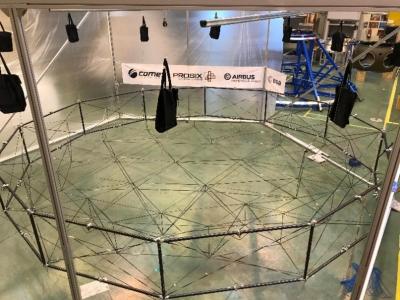MODULAR Deployable Structures

Development of large deployable structures concepts for Science, Earth Observation, Telecommunications and Navigation applications
Large apertures (antennas and telescopes) and long baselines and focal lengths in space have applications for telecommunications, Earth observation and scientific missions. Astrophysics missions need deployable structures mostly for the creation of long base lines of interferometers and large focal lengths, e.g. for X-ray telescopes. Missions currently in early phases may require for instance deployable booms of up to 100 m deployed length and positioning accuracy within a sphere of 1 mm radius or better and rotations lower than 0.005 degree. Taking into account the requirements of telecommunications, Earth observation and radio-astronomy, the functional requirements on the antennas can be divided into two main groups in terms of projected aperture. In the first group it is required a projected aperture of 4-7 m with an RMS surface accuracy around wavelength/50 (i.e. 2.5 mm in S band) for applications mostly in L and S bands or wavelength/50 to wavelength/100 for applications from C to Ka band (i.e. 0.1 mm in Ka band). The second group corresponds to projected apertures in the range of 9-25 m with an RMS surface accuracy around wavelength/50 for applications mostly in UHF and L/S bands. Higher operational frequencies can be required for particular cases such as radiometry and radio astronomy. The pointing stability of the reflector assembly including the deployable arm should be in the range of 0.01 to 0.1 degree half cone. Concerning mass, the technology state of the art is around 1 kg/m2 for the very large apertures, meanwhile for the higher accuracies 2 to 5 kg/m2 are often the case. The required stiffness is closely related to the AOCS disturbances and spacecraft station-keeping and re-pointing operations. In Earth observation applications, especially Synthetic Aperture Radar (SAR) in L, C and X bands, reflector-based concepts compete with phased arrays. Large deployable reflector antennas over 15 m aperture have been identified as having potential for such L-band missions. Meanwhile, the BIOMASS mission has been selected by ESA as an Earth Explorer Core Mission. The primary objective of the mission is to estimate forest biomass by means of P-band (435MHz) SAR observations of global forest cover. This mission requires a reflector with an aperture of 12 m. In addition to SAR, radiometry has also been identified as a potential user of these large apertures. Resolution requirements physically dictate the instrument sensor and therefore the antenna sizing, with particular impact on the lower frequency bands.Within this context of missions and technological needs, the position of Europe is very weak as compared to US, Japan and China. Scalable deployable technologies are being addressed, but not yet the modular construction principles. Modular deployable structures enable a flexible architecture and, more important, on ground Verification and Model Philosophy simplification and cost reduction of large structures. The activity proposed is planned to address the needs of the potential missions by developing modules of deployable booms (linear structure) and rings (antenna/telescope aperture). The development shall address the analytical prediction in combination with on-ground testing in order to develop also the Verification methods necessary to reduce development cost of future steps. Two demonstrator models shall be manufactured and tested, following a first phase of mission selection, requirements consolidation and preliminary design.
